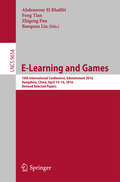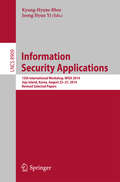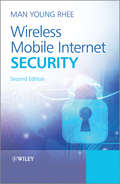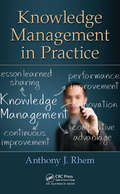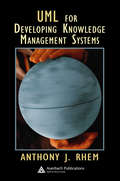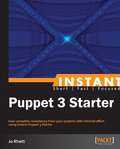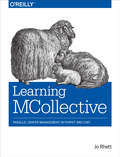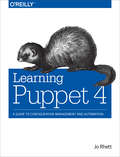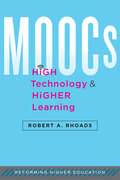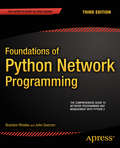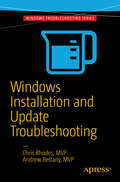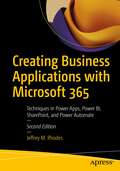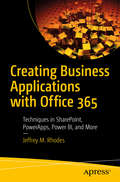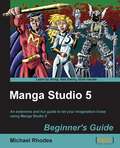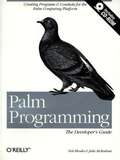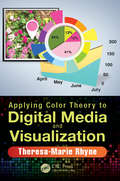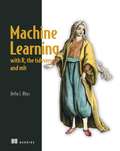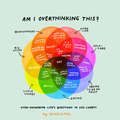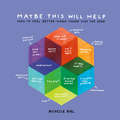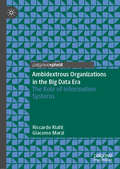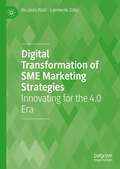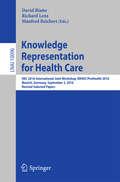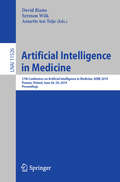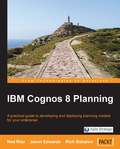- Table View
- List View
E-Learning and Games
by Abdennour El Rhalibi Feng Tian Zhigeng Pan Baoquan LiuThis book constitutes the refereed proceedings of the 10th International Conference on E-Learning and Games, Edutainment 2016, held in Hangzhou, China, in April 2016. The 36 full papers presented were carefully reviewed and selected from 60 submissions. They are organized in the following topical sections: E-learning and game; graphics, imaging and applications; intelligent data analytics and visualization.
Information Security Applications
by Kyung-Hyune Rhee Jeong Hyun YiThis book constitutes the thoroughly refereed proceedings of the 15th International Workshop on Information Security Applications, WISA 2014, held on Jeju Island, Korea, in August 2014. The 30 revised full papers presented in this volume were carefully reviewed and selected from 69 submissions. The papers are organized in topical sections such as malware detection; mobile security; vulnerability analysis; applied cryptography; network security; cryptography; hardware security; and critical infrastructure security and policy.
Wireless Mobile Internet Security
by Man Young RheeThe mobile industry for wireless cellular services has grown at a rapid pace over the past decade. Similarly, Internet service technology has also made dramatic growth through the World Wide Web with a wire line infrastructure. Realization for complete wired/wireless mobile Internet technologies will become the future objectives for convergence of these technologies through multiple enhancements of both cellular mobile systems and Internet interoperability. Flawless integration between these two wired/wireless networks will enable subscribers to not only roam worldwide, but also to solve the ever increasing demand for data/Internet services. In order to keep up with this noteworthy growth in the demand for wireless broadband, new technologies and structural architectures are needed to greatly improve system performance and network scalability while significantly reducing the cost of equipment and deployment. Dr. Rhee covers the technological development of wired/wireless internet communications in compliance with each iterative generation up to 4G systems, with emphasis on wireless security aspects. By progressing in a systematic matter, presenting the theory and practice of wired/wireless mobile technologies along with various security problems, readers will gain an intimate sense of how mobile internet systems operate and how to address complex security issues. Features: Written by a top expert in information security Gives a clear understanding of wired/wireless mobile internet technologies Presents complete coverage of various cryptographic protocols and specifications needed for 3GPP: AES, KASUMI, Public-key and Elliptic curve cryptography Forecast new features and promising 4G packet-switched wireless internet technologies for voice and data communications Provides MIMO/OFDMA-based for 4G systems such as Long Term Evolution (LTE), Ultra Mobile Broadband (UMB), Mobile WiMax or Wireless Broadband (WiBro) Deals with Intrusion Detection System against worm/virus cyber attacks The book ideal for advanced undergraduate and postgraduate students enrolled in courses such as Wireless Access Networking, Mobile Internet Radio Communications. Practicing engineers in industry and research scientists can use the book as a reference to get reacquainted with mobile radio fundamentals or to gain deeper understanding of complex security issues.
Knowledge Management in Practice
by Anthony J. Rhem"This evidence-based book provides the framework and guidelines that professionals need for working with the contemporary explosion of data that is creating opportunities and challenges to all phases of our society and commerce." –Larry R. Medsker, Research Professor in Physics and Data Science, The George Washington University Knowledge Management in Practice is a resource on how knowledge management (KM) is implemented. It provides specific KM methods, tips, techniques, and best practices to gain competitive advantage and the most from investing in KM. It examines how KM is leveraged by first responders, the military, healthcare providers, insurance and financial services companies, legal firms, human resources departments, merger and acquisition (M&A) firms, and research institutions. Essential KM concepts are explored not only from a foundational perspective but also from a practical application. These concepts include capturing and codifying tacit and explicit knowledge, KM methods, information architecture, search, KM and social media, KM and Big Data, and the adoption of KM. Readers can visit the book’s companion website, KM Mentor (www.KMMentor.com), where they can access: Presentations by industry leaders on a variety of topics KM templates and instruction on executing KM strategy, performing knowledge transfer, and KM assessments and audits KM program and project implementation guidance Insights and reviews on KM tools Guidance on implementing and executing various KM Methods Specialized KM publications A private secure collaboration community for members to discuss ideas and get expert answers and advice
UML for Developing Knowledge Management Systems
by Anthony J. RhemUML for Developing Knowledge Management Systems provides knowledge engineers the framework in which to identify types of knowledge and where this knowledge exists in an organization. It also shows ways in which to use a standard recognized notation to capture, or model, knowledge to be used in a knowledge management system (KMS).This volume
Instant Puppet 3 starter
by Jo RhettGet to grips with a new technology, understand what it is and what it can do for you, and then get to work with the most important features and tasks. This book is an awesome guide for understanding and developing your skills set with instant Puppet 3. It consists of friendly practical tutorials, with an informative step by step walk through.Instant Puppet 3 helps to simplify your life for large scale computing clusters. It is aimed at systems administrators, developers, DevOps engineers and anyone who manages more than one computer. This is a practical and intuitive instant starter guide, guaranteed to improve your understanding and efficiency.
Learning MCollective
by Jo RhettOrchestrate change across server clusters in near realtime with MCollective, the framework that works in concert with Puppet, Chef, and other configuration management tools. Ideal for system administrators and operations or DevOps engineers at any level, this hands-on guide teaches you how to build and test a real installation of MCollective servers and clients in your environment.Learn how to build an entire installation by hand, know where every configuration file lives, and understand every configuration parameter and what it means. Whether you manage a small environment or one that's immense in scale, this book shows you how to orchestrate specific actions faster and better than you do now.Tour MCollective's architecture, backbone, transport, and security controlsConfigure MCollective components to match your production environmentCreate and use collectives to handle thousands of remote MCollective agentsUse ActiveMQ Network of Brokers to resolve multi-site or redundancy requirementsLearn how to use community-built client and agent plugins, with concrete examplesCreate your own server and client plugins to perform a variety of actionsLearn recommended best practices for using MCollective
Learning MCollective: Parallel Server Management in Puppet and Chef
by Jo RhettOrchestrate change across server clusters in near realtime with MCollective, the framework that works in concert with Puppet, Chef, and other configuration management tools. Ideal for system administrators and operations or DevOps engineers at any level, this hands-on guide teaches you how to build and test a real installation of MCollective servers and clients in your environment.Learn how to build an entire installation by hand, know where every configuration file lives, and understand every configuration parameter and what it means. Whether you manage a small environment or one that’s immense in scale, this book shows you how to orchestrate specific actions faster and better than you do now.Tour MCollective’s architecture, backbone, transport, and security controlsConfigure MCollective components to match your production environmentCreate and use collectives to handle thousands of remote MCollective agentsUse ActiveMQ Network of Brokers to resolve multi-site or redundancy requirementsLearn how to use community-built client and agent plugins, with concrete examplesCreate your own server and client plugins to perform a variety of actionsLearn recommended best practices for using MCollective
Learning Puppet 4: A Guide to Configuration Management and Automation
by Jo RhettIf you're a system administrator, developer, or site reliability engineer responsible for handling hundreds or even thousands of nodes in your network, the Puppet configuration management tool will make your job a whole lot easier. This practical guide shows you what Puppet does, how it works, and how it can provide significant value to your organization.Through hands-on tutorials, DevOps engineer Jo Rhett demonstrates how Puppet manages complex and distributed components to ensure service availability. You'll learn how to secure configuration consistency across servers, clients, your router, and even that computer in your pocket by setting up your own testing environment.Learn exactly what Puppet is, why it was created, and what problems it solvesTailor Puppet to your infrastructure with a design that meets your specific needsWrite declarative Puppet policies to produce consistency in your systemsBuild, test, and publish your own Puppet modulesManage network devices such as routers and switches with puppet device and integrated Puppet agentsScale Puppet servers for high availability and performanceExplore web dashboards and orchestration tools that supplement and complement Puppet
MOOCs, High Technology, and Higher Learning (Reforming Higher Education: Innovation and the Public Good)
by Robert A. RhoadsThe first book to explore the rise of MOOCs through a social science lens.In MOOCs, High Technology, and Higher Learning, Robert A. Rhoads places the OpenCourseWare (OCW) movement into the larger context of a revolution in educational technology. In doing so, he seeks to bring greater balance to increasingly polarized discussions of massively open online courses (MOOCs) and show their ongoing relevance to reforming higher education and higher learning.Rhoads offers a provocative analysis of a particular moment in history when cultural, political, and economic forces came together with evolving teaching and learning technologies to bring about the MOOC. He argues persuasively that the OCW and MOOC movements have had a significant impact on the digitalization of knowledge and that they have helped expand the ways students and teachers interact and develop ideas collaboratively. He also critically analyzes the extensive media coverage of MOOCs while examining empirical studies of MOOC content delivery, the organizational system supporting the OCW/MOOC movement, and faculty labor concerns.Too often, technology advocates champion the MOOC movement as a solution to higher education’s challenges without recognizing the pedagogical, social, and economic costs. MOOCs, High Technology, and Higher Learning challenges many of the democratic claims made by MOOC advocates, pointing to vast inequities in the ways MOOCs are presented as an alternative to brick-and-mortar access for low-income populations. This book offers a clear-eyed perspective on the potential and peril of this new form of education.
Foundations of Python Network Programming
by Brandon Rhodes John GoerzenFoundations of Python Network Programming, Third Edition, covers all of the classic topics found in the second edition of this book, including network protocols, network data and errors, email, server architecture, and HTTP and web applications, plus updates for Python 3. Some of the new topics in this edition include: * Extensive coverage of the updated SSL support in Python 3 * How to write your own asynchronous I/O loop. * An overview of the "asyncio" framework that comes with Python 3. 4. * How the Flask web framework connects URLs to your Python code. * How cross-site scripting and cross-site request forgery can be used to attack your web site, and how to protect against them. * How a full-stack web framework like Django can automate the round trip from your database to the screen and back. If you're a Python programmer who needs a deep understanding of how to use Python for network-related tasks and applications, this is the book for you. From web application developers, to systems integrators, to system administrators--this book has everything that you need to know. What you'll learn * Extensive coverage of the updated SSL support in Python 3 * How to write your own asynchronous I/O loop. * An overview of the "asyncio" framework that comes with Python 3. 4. * How the Flask web framework connects URLs to your Python code. * How cross-site scripting and cross-site request forgery can be used to attack your web site, and how to protect against them. * How a full-stack web framework like Django can automate the round trip from your database to the screen and back. * Updated coverage of network protocol layers and data encodings * How Python 3 works with network exception handling * How to use the requests library instead of urllib2 * Expanded coverage of Python web frameworks * How to work with web applications and email Who this book is for If you're a Python programmer who needs a deep understanding of how to use Python for network-related tasks and applications, this is the book for you. From web application developers, to systems integrators, to system administrators--this book has everything that you need to know. Table of Contents Introduction to Client/Server Networking UDP TCP Socket Names and DNS Network Data and Network Errors TLS and SSL Server Architecture Caches, Message Queues, and Map-Reduce HTTP Screen Scraping Web Applications E-mail Composition and Decoding SMTP POP IMAP Other technologies: Telnet, SSH, and FTP RPC System Administration
Windows Installation and Update Troubleshooting
by Chris Rhodes Andrew BettanyUnderstand, troubleshoot and repair issues with local Windows installations, automating the OS deployment and configuring updates via WSUS and Windows Intune. When tasked with deploying Windows operating systems, there can seem to be an overwhelming amount of tools and techniques to learn to master this process. Whether you are installing a new Windows operating system locally, or looking to deploy a customized build to 1000s of devices in your network, you will need to understand how to do this successfully and reliably. This book steps up through local installations and upgrades through to Lite Touch deployments using WDS and MDT, and then to Zero Touch installations using Microsoft System Center. Management of updates to Windows is also covered, using both on-premises technologies and cloud-based services. In this book you'll learn how to decide between local installation types, perform upgrades, use automation techniques to deploy images and how to maintain Windows throughout the operational phase of the lifecycle. What You'll Learn Install Windows 7, 8. 1, or 10 locally Perform upgrades locally on a Windows PC, including migrating data and user profiles Deploy operating systems using Lite Touch techniques Deploy operating systems using Zero Touch technologies Maintain on-premises and devices not connected to the company network by using WSUS and Windows Intune Who This Book Is For IT pros including IT support personnel and system administrators. This book will also be of interest to Windows experts and power users.
Creating Business Applications with Microsoft 365: Techniques in Power Apps, Power BI, SharePoint, and Power Automate
by Jeffrey M. RhodesLearn how to automate processes, visualize your data, and improve productivity using Power Apps, Power Automate, Power BI, SharePoint, Forms, Teams, and more. This book will help you build complete solutions that often involve storing data in SharePoint, creating a front-end application in Power Apps or Forms, adding additional functionality with Power Automate, and effective reports and dashboards in Power BI. This new edition greatly expands the focus on Power Apps, Power BI, Power Automate, and Teams, along with SharePoint and Microsoft Forms. It starts with the basics of programming and shows how to build a simple email application in .NET, HTML/JavaScript, Power Apps on its own, and Power Apps and Power Automate in combination. It then covers how to connect Power Apps to SharePoint, create an approval process in Power Automate, visualize surveys in Power BI, and create your own survey solution with the combination of a number of Microsoft 365 tools. You’ll work with an extended example that shows how to use Power Apps and SharePoint together to create your own help ticketing system. This book offers a deep dive into Power BI, including working with JSON, XML, and Yes/No data, as well as visualizing learning data and using it to detect inconsistencies between Excel files. You’ll also see how to connect to Remedy and to the help system you will have created. Under author Jeffrey Rhodes’s guidance, you’ll delve into the Power Apps collection to learn how to avoid dreaded "delegation" issues with larger data sets. Back on applications, you will create a training class sign-up solution to only allow users to choose classes with available seats. Digging deeper into Teams, you’ll learn how to send chats, posts, and "adaptive cards" from Power Automate. Rounding things out, you’ll save Forms attachments to SharePoint with Power Automate, create your own "Employee Recognition" app with all of the Power Platform and Teams, add or edit weekly status reports, and learn how to create reservation and scoring applications. After reading the book, you will be able to build powerful applications using Power Apps, Power Automate, Power BI, SharePoint, Forms, and Teams. What You Will Learn Create productivity-enhancing applications with Power Apps, Power Automate, SharePoint, Forms, and/or TeamsTransform and visualize data with Power BI to include custom columns, measures, and pivotsAvoid delegation issues and tackle complicated Power Apps issues like complex columns, filtering, and ForAll loopsBuild scheduled or triggered Power Automate flows to schedule Teams Meetings, send emails, launch approvals, and much more Who This Book Is For Business and application developers.
Creating Business Applications with Office 365: Techniques in SharePoint, PowerApps, Power BI, and More
by Jeffrey M. RhodesTake your Office 365 and SharePoint projects to a higher level by using PowerApps, Flow, Power BI, JavaScript/jQuery jQuery UI widgets, Cascading Style Sheets (CSS), and more. This book will help you create easier solutions to client-side problems and applications. Additionally, you will be able to effectively visualize your data with Power BI.This book starts with configuration of SharePoint and Office 365 followed by your first example of PowerApps. You will lay the foundation for a help ticket application and see how to update a SharePoint list with PowerApps. You then will work with the jQuery open source library and learn how to use the developer tools within your browser. This allows you to customize data displays in SharePoint. Next, you will add jQuery UI widgets such as buttons and dialogs to SharePoint, learning how to configure and manipulate them via JavaScript. You will use these new skills to convert a normal SharePoint announcement into a visually compelling page of network alerts. You also will use JavaScript and styles to hugely improve native SharePoint calendars by color-coding them by category or location. To prevent overlapping events in calendars, you will work with SharePoint's web services and JavaScript. You will use similar concepts to make appealing accordion SharePoint pages. You then will explore Microsoft Forms, Flow, and Power BI, including building surveys in both Forms and SharePoint and using Power BI to show results over the last week, month, quarter, and year. Using advanced Power BI you will see how to deal with JSON, XML, and Yes/No data. Next, you will look at how to display Office documents as well as interact with them via JavaScript. Switching back to PowerApps, you will build the final help ticketing system before using Power BI to see how to visualize the ticket information. After a quick detour on using iFrames in SharePoint, you will jump into building a power routing application using InfoPath and SharePoint Designer. You will even call SharePoint’s web services from Designer to customize email notifications. You end the InfoPath set of chapters with a highly useful application for signing up for and managing attendance for training and other classes. Finally, you will add Google Analytics to track SharePoint usage.What You Will LearnBuild powerful applications with PowerAppsExtend SharePoint’s capabilities using JavaScript Create surveys with SharePoint and Microsoft Forms, copy the results to SharePoint using Flow, and visualize the data with Power BIEmploy advanced Power BI techniques to include custom columns, pivoting, and dealing with JSON, XML, and Yes/No dataUse InfoPath and SharePoint workflows to create routing systems, schedule classes, and other advanced tasksWho This Book Is ForBusiness and application developers
Manga Studio 5 Beginner's Guide
by Michael RhodesUsing a step-by-step approach, this book will lead you through the process of building up complex, multi-page comic/Manga art, along with industry insights along the way. "Manga Studio Beginner's Guide" is for beginners in comic creation. The more you know about how comics are made, the better you will be, but it's not essential to get the most out of this book. Even if you're a professional comic artist, this book will get you up to speed on using Manga Studio 5.
Palm Programming: The Developer's Guide
by Neil Rhodes Julie MckeehanPalmPilot's popularity is growing and with over a million units sold, the Palm OS dominates the hand-held market. Wired has astutely described Palm's position in a recent article: "On its way to becoming the bestselling hand-held computer of all time, the 3Com PalmPilot has spawned an intense, emotional, and fanatical developer following not seen since the glory days of the Mac." (Wired, 20 Feb. 98). Palm Programming should be eagerly accepted by programmers because the authors worked closely with Palm to ensure that the book is tailored exactly to the needs of the ever-growing group of Palm developers. As nothing but some piecemeal documentation exists currently, this book provides a much needed solution to the Palm developers. In fact, Palm uses this book as their official developer's guide and will be using it in the future as a key part of their training materials for developers. There are currently no books on Palm programming (and we know of none that are planned). The only way to learn is by using the reference material published by Palm (available freely on their Web site), the tutorial they provide, or various Palm programming FAQs compiled by third parties. Palm Programming shows intermediate to experienced C programmers how to build a Palm application from the ground up. Using an easy-to- understand tutorial approach, this book gives readers everything necessary to create a wide range of Palm applications and conduits, from simple scripts through full-blown applications, and in the process provides thorough coverage of Palm programming. It includes a CD-ROM (Macintosh and Windows compatible) with the full source code to the examples in the book, a trial version of Palm's Software Development Kit, and third-party developer tools, including Metrowerks' CodeWarrior Lite programming kit. Outline Part 1: Overview of Palm OS and devices Chapter 1: The Palm Solution Chapter 2: Developing for Palm OS Chapter 3: Designing a solution Part 2: Programming for the handheld Chapter 4: Structure of an Application Chapter 5: Forms and Form Objects Chapter 6: Databases Chapter 7: Menus Chapter 8: Extras Chapter 9: Communications Chapter 10: Debugging Part 3: Programming for the desktop: conduits Chapter 11: Getting started with conduits Chapter 12: Uploading and Downloading Data Chapter 13: Two-way Syncing Appendix: Where to go from here
Applying Color Theory to Digital Media and Visualization
by Theresa-Marie RhyneThis book provides an overview of the application of color theory concepts to digital media and visualization. It highlights specific color concepts like color harmony and shows how to apply the concept with case study examples and usage of actual online and mobile color tools. Color deficiencies are reviewed and discussed are color tools for examining how a specific color map design will look to someone with the deficiency. Other books on color examine artists' use of color, color management, or color science. This book applies fundamental color concepts to digital media and visualization solutions. It is intended for digital media and visualization content creators and developers. Presents Color Theory Concepts that can be applied to digital media and visualization problems over and over again Offers Comprehensive Review of the Historical Progression of Color Models Demonstrates actual case study implementations of color analyses tools Provides overview of Color Theory and Harmony Analytics in terms of online and mobile analysis tools Teaches the color theory language to use in interacting with color management professionals
Machine Learning with R, the tidyverse, and mlr
by Hefin RhysSummary Machine learning (ML) is a collection of programming techniques for discovering relationships in data. With ML algorithms, you can cluster and classify data for tasks like making recommendations or fraud detection and make predictions for sales trends, risk analysis, and other forecasts. Once the domain of academic data scientists, machine learning has become a mainstream business process, and tools like the easy-to-learn R programming language put high-quality data analysis in the hands of any programmer. Machine Learning with R, the tidyverse, and mlr teaches you widely used ML techniques and how to apply them to your own datasets using the R programming language and its powerful ecosystem of tools. This book will get you started! Purchase of the print book includes a free eBook in PDF, Kindle, and ePub formats from Manning Publications. About the book Machine Learning with R, the tidyverse, and mlr gets you started in machine learning using R Studio and the awesome mlr machine learning package. This practical guide simplifies theory and avoids needlessly complicated statistics or math. All core ML techniques are clearly explained through graphics and easy-to-grasp examples. In each engaging chapter, you&’ll put a new algorithm into action to solve a quirky predictive analysis problem, including Titanic survival odds, spam email filtering, and poisoned wine investigation. What's inside Using the tidyverse packages to process and plot your data Techniques for supervised and unsupervised learning Classification, regression, dimension reduction, and clustering algorithms Statistics primer to fill gaps in your knowledge About the reader For newcomers to machine learning with basic skills in R. About the author Hefin I. Rhys is a senior laboratory research scientist at the Francis Crick Institute. He runs his own YouTube channel of screencast tutorials for R and RStudio. Table of contents: PART 1 - INTRODUCTION 1.Introduction to machine learning 2. Tidying, manipulating, and plotting data with the tidyverse PART 2 - CLASSIFICATION 3. Classifying based on similarities with k-nearest neighbors 4. Classifying based on odds with logistic regression 5. Classifying by maximizing separation with discriminant analysis 6. Classifying with naive Bayes and support vector machines 7. Classifying with decision trees 8. Improving decision trees with random forests and boosting PART 3 - REGRESSION 9. Linear regression 10. Nonlinear regression with generalized additive models 11. Preventing overfitting with ridge regression, LASSO, and elastic net 12. Regression with kNN, random forest, and XGBoost PART 4 - DIMENSION REDUCTION 13. Maximizing variance with principal component analysis 14. Maximizing similarity with t-SNE and UMAP 15. Self-organizing maps and locally linear embedding PART 5 - CLUSTERING 16. Clustering by finding centers with k-means 17. Hierarchical clustering 18. Clustering based on density: DBSCAN and OPTICS 19. Clustering based on distributions with mixture modeling 20. Final notes and further reading
Am I Overthinking This?: Over-answering life's questions in 101 charts
by Michelle RialDid I screw up? How do I achieve work-life balance? Am I eating too much cheese? Do I have too many plants? Through artful charts and funny, insightful questions, Michelle Rial delivers a playful take on the little dilemmas that loom large in the mind of every adult. Building on her popular Instagram account, Am I Overthinking This? brings whimsical charm to topics big and small, and offers solidarity for the stressed, answers for the confused, and a good laugh for all.
Maybe This Will Help: How to Feel Better When Things Stay the Same
by Michelle RialA visual pep talk of charts and essays on feeling better about not feeling better.Maybe This Will Help is one part the funny and relatable graphs that fans of Am I Overthinking This? and of Michelle Rial know and love, and one part the honest stories behind what makes those graphs so poignant. Michelle Rial brings to light her struggles with chronic pain, grief, and creative uncertainty in a way that reflects the universality of dealing with the unthinkable. Equal parts funny and moving, this book delves into the more serious side of things, finding levity and collective experience in the invisible difficulties that so many of us face. Through humorous charts and intimate peeks into the author's life, it explores the big things that can feel unmanageable and the everyday humor that keeps us moving forward.SELF-HELP WITH HUMOR: This book brings levity and laughter to serious topics without undermining the important message and relatability that makes it resonate.BELOVED AUTHOR: Michelle Rial's first book was beloved by her tens of thousands of fans as well as by the media, including Wired, Vulture, Book Riot—and the New Yorker even published her chart-based article on "Book Publishing by the Numbers."JUST THE RIGHT TONE: This book perfectly captures trying to figure out the "magic pill" that will fix things, struggling to find peace in how things are, and the humor in even the hardest times. It makes an ideal gift for someone struggling with physical or mental pain when you want to help but aren't sure how to.Perfect for: Fans of Michelle Rial's Instagram and first book, Am I Overthinking This?; people in their 20s and 30s grappling with big life changes or chronic illness
Ambidextrous Organizations in the Big Data Era: The Role of Information Systems
by Riccardo Rialti Giacomo MarziAddressing the effect of big data analytics-capable information systems on organizational ambidexterity, this book investigates how these systems can be used to enhance organizational agility and flexibility, generally considered to be two key determinants of organizational ambidexterity. With a focus on the opportunities for businesses rather than the burden that big data can represent, the authors highlight the impact of big data on ambidextrous organizations and how current organizational structures can be modified in order to improve big data analytics and implement big data-capable information systems.
Digital Transformation of SME Marketing Strategies: Innovating for the 4.0 Era
by Riccardo Rialti Lamberto ZolloSMEs represent more than 95% of businesses operating in global markets. These businesses are the fabric of any economic system both in developed and emerging countries, and are the main constituents of any global supply chain throughout the world. However, research on new 4.0 marketing strategies for this kind of businesses has been largely neglected. Extant literature mostly neglects, or fails to articulate the importance of emerging technology such as Big Data, Artificial Intelligence and VR/AR for SMEs. Building on that, this book reviews existing literature on innovation and new technology in marketing for SMEs, what they could do and should avoid. Then, presenting multiple case study from SMEs operating in diverse industries (fashion and design, food and wine, financial services), it develops a practical strategic framework that could be used by SMEs wishing to effectively innovate their marketing strategies in our contemporary digital era. It will be an essential resource for students and researchers of marketing, innovation and industry 4.0.
Knowledge Representation for Health Care
by David Riaño Richard Lenz Manfred ReichertThis book constitutes the thoroughly refereedpost-workshop proceedings of two workshops held at the International Conferenceon Artificial Intelligence in Medicine, AIME 2015, held in Pavia, Italy, inJune 2015: the 7th International Workshop on Knowledge Representation forHealth Care, KR4HC 2015, and the 8th International Workshop on Process-orientedInformation Systems in Healthcare, ProHealth 2015. The 10 revised full papers were carefullyreviewed and selected from 26 submissions. The papers are organized in topicalsections on knowledge-driven health IT and simulation, clinical guideline andclinical pathway support, mobile process and decision support, and healthinformation systems and clinical data.
Artificial Intelligence in Medicine: 17th Conference on Artificial Intelligence in Medicine, AIME 2019, Poznan, Poland, June 26–29, 2019, Proceedings (Lecture Notes in Computer Science #11526)
by David Riaño Annette Ten Teije Szymon WilkThis book constitutes the refereed proceedings of the 17th Conference on Artificial Intelligence in Medicine, AIME 2019, held in Poznan, Poland, in June 2019. The 22 revised full and 31 short papers presented were carefully reviewed and selected from 134 submissions. The papers are organized in the following topical sections: deep learning; simulation; knowledge representation; probabilistic models; behavior monitoring; clustering, natural language processing, and decision support; feature selection; image processing; general machine learning; and unsupervised learning.
IBM Cognos 8 Planning
by Ned Riaz Jason EdwardsThis is a step-by-step, practical guide to designing, building, and deploying Planning models, with plenty of advice from three of the most seasoned Cognos Planning consultants having over 25 years of real-world, in-the-trench experience. We remove the technical clutter and jump right to the heart of the subject focusing only on what is important. Written for first-time developers wanting an introduction to IBM Cognos Planning, this book gives clear, easy-to-understand instructions on how to design, build, and deploy Planning models focusing only on the essential tools that you need to know. It is for anyone who wants to understand IBM Cognos Planning and make a transition to this tool from elsewhere.
